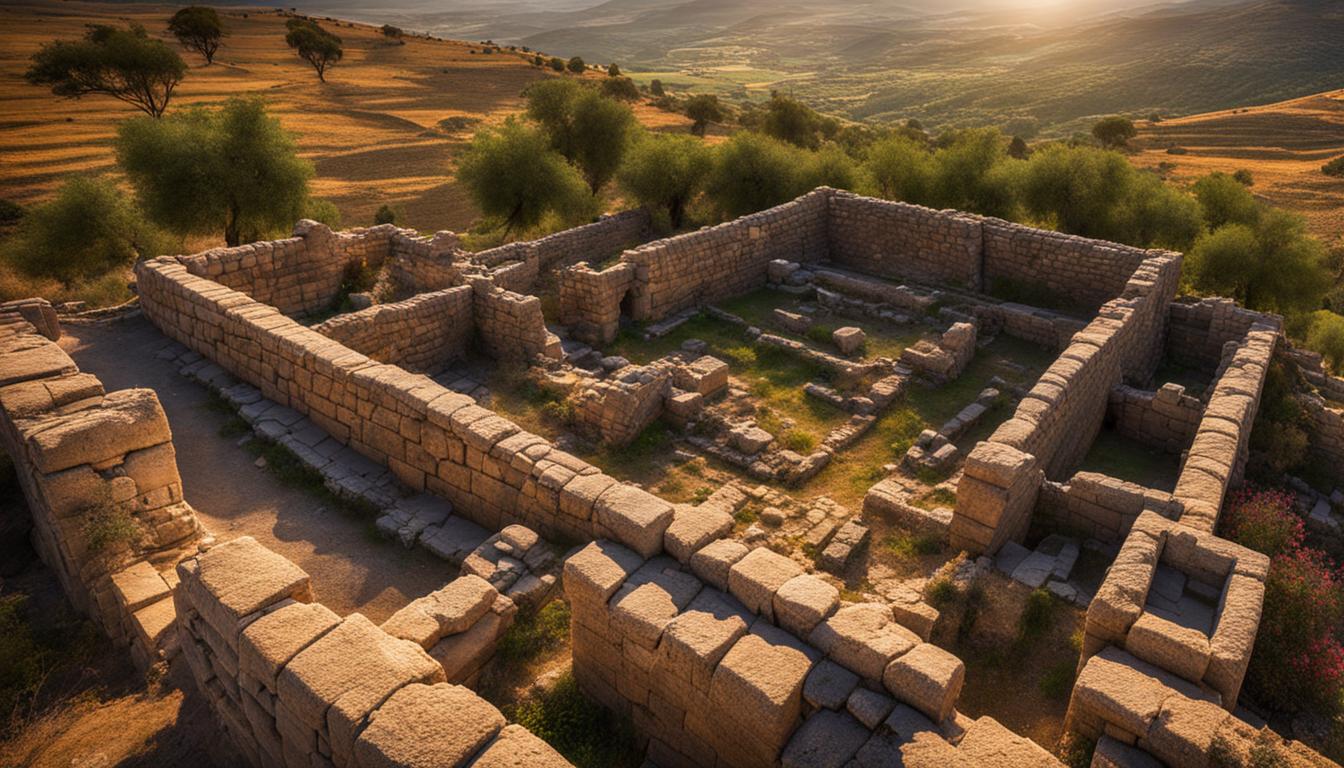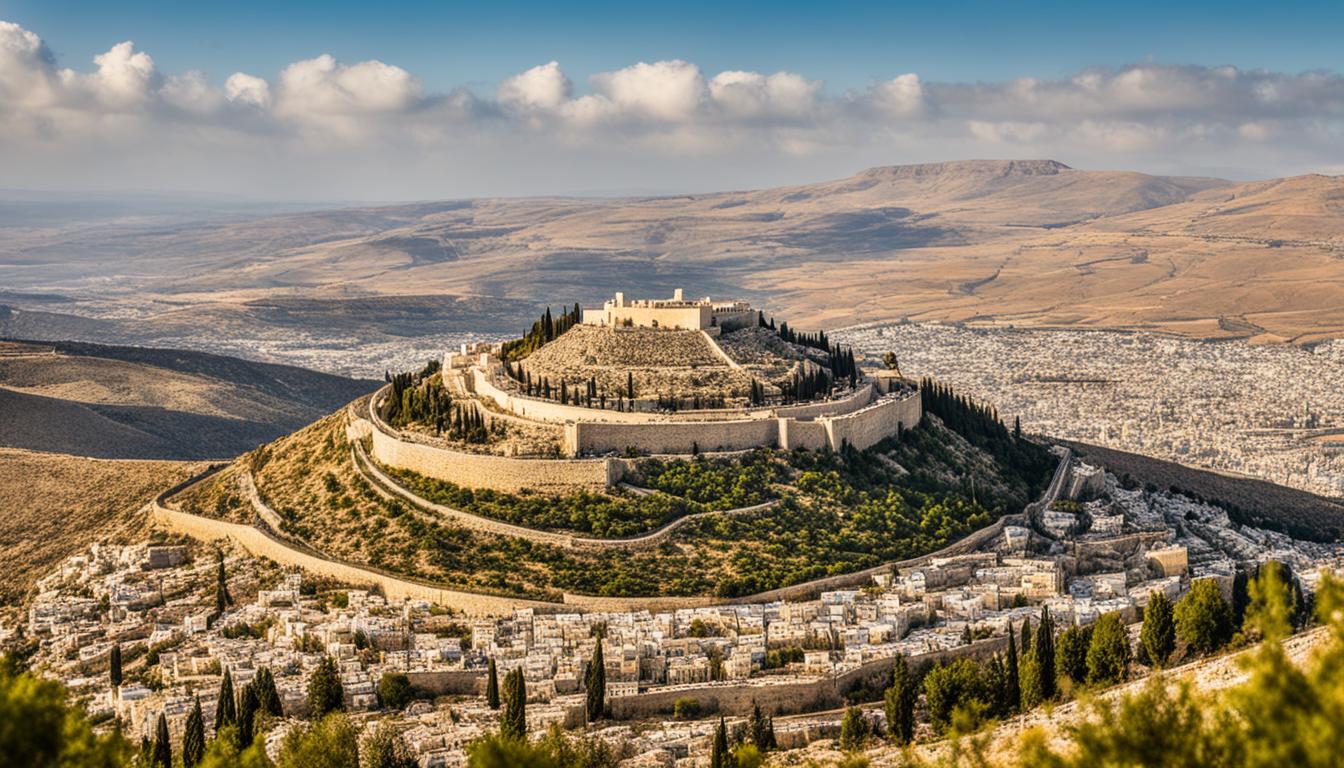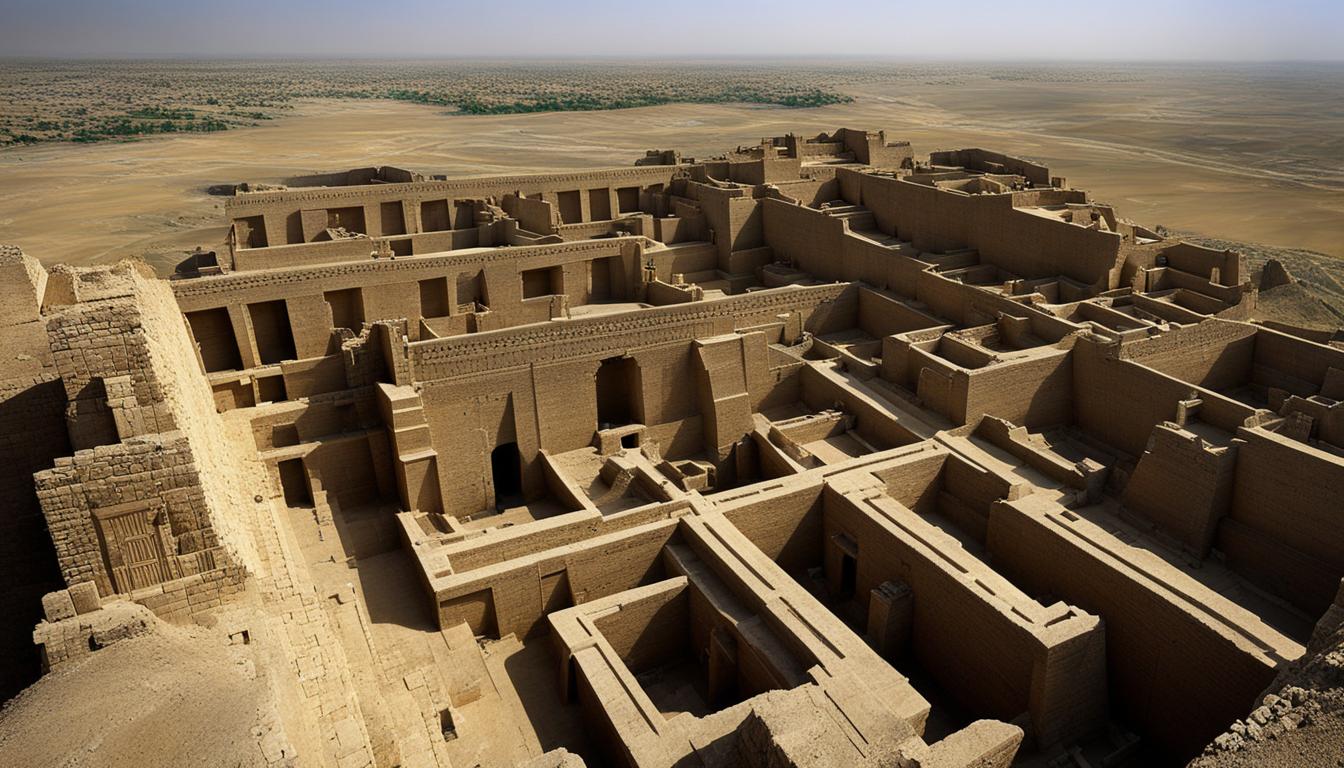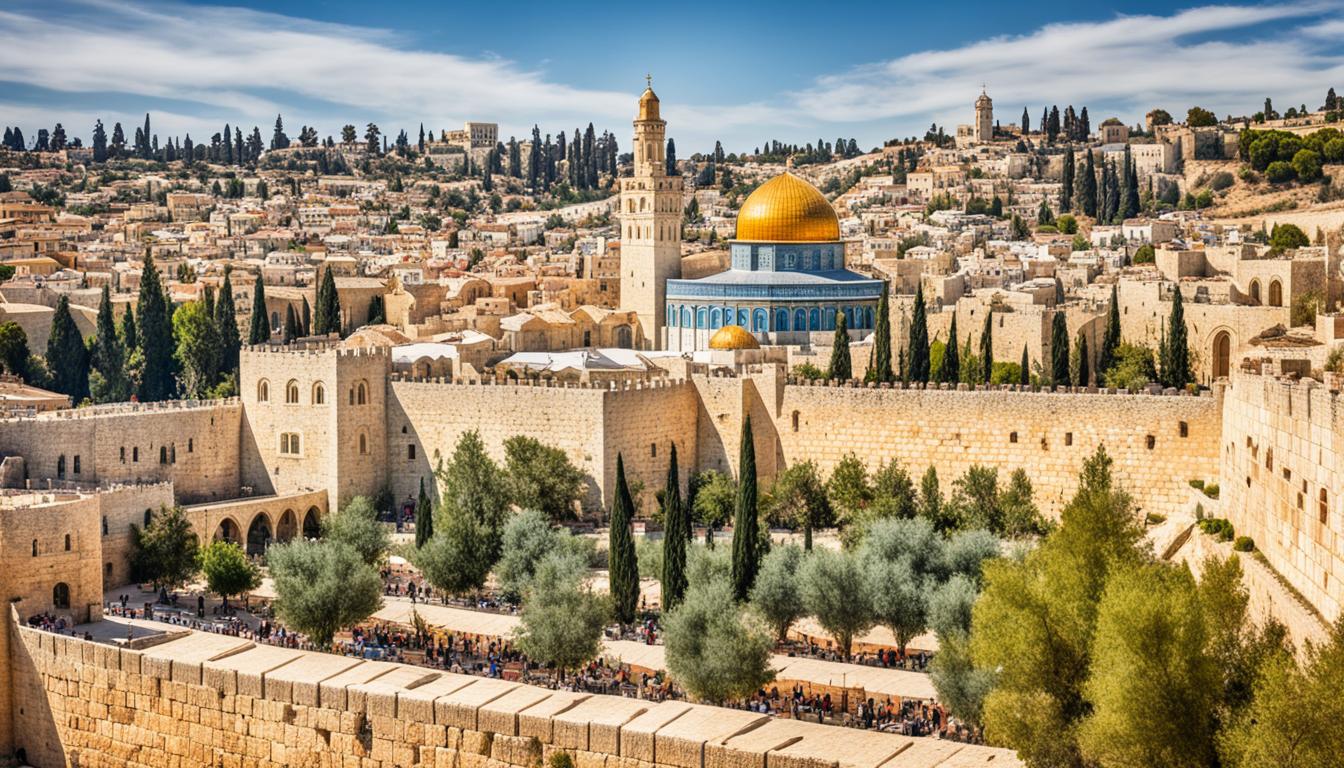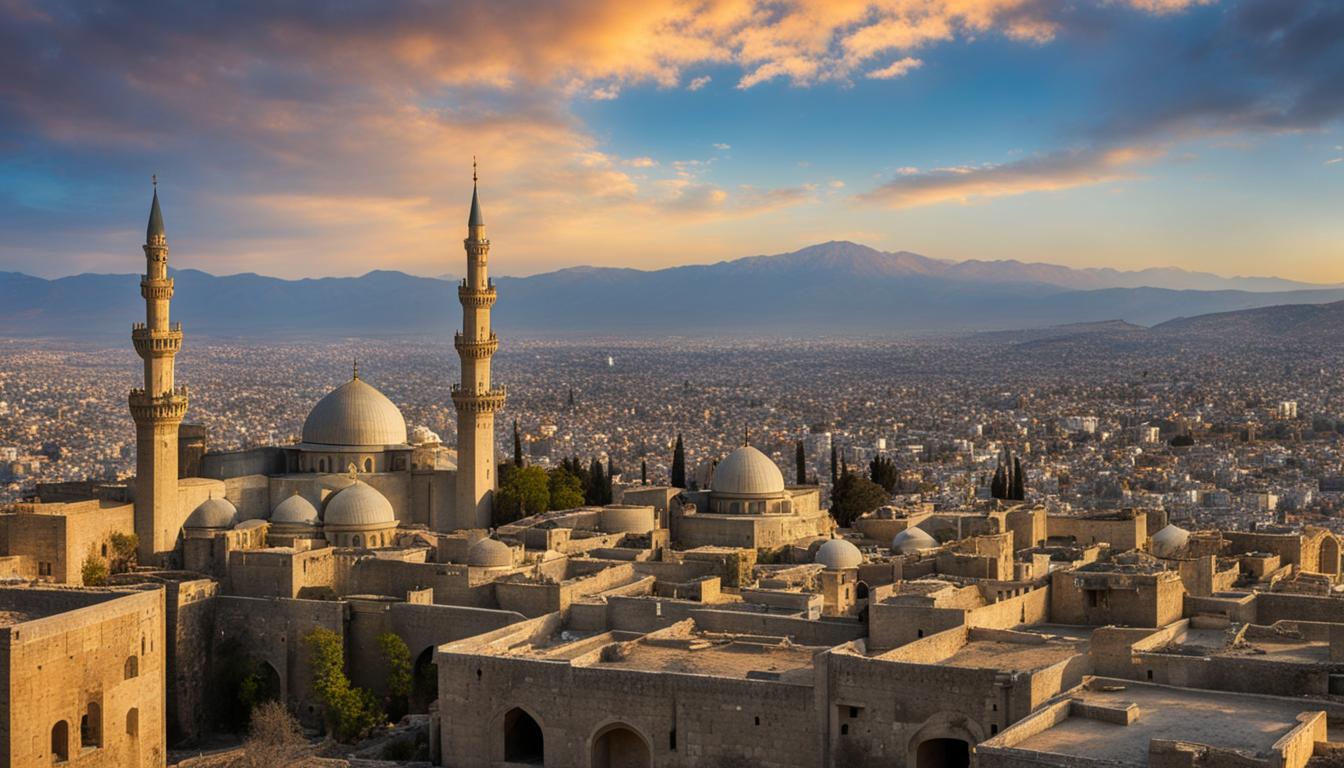Samaria holds a significant place in the Bible, featuring prominently in both the Old and New Testaments. It is a region that carries deep biblical history and is rich in cultural and religious significance.
The ancient city of Samaria originated from the Northern Kingdom of Israel after the Assyrian conquest in 722 BCE. Throughout the Bible, Samaria is mentioned in various biblical references, showcasing its importance in the narratives of the Israelites and their prophets.
The encounters between Jesus and Samaritans, such as the Parable of the Good Samaritan and the encounter with the Samaritan woman at the well, highlight the themes of compassion, inclusivity, and the universality of salvation. These stories emphasize the timeless lesson of breaking down cultural and religious barriers to embrace love and mercy.
- Samaria plays a significant role in both the Old and New Testaments.
- The region originated from the Northern Kingdom of Israel after the Assyrian conquest.
- Encounters between Jesus and Samaritans highlight themes of compassion and inclusivity.
- Samaria serves as a timeless lesson on breaking down cultural and religious barriers.
- Exploring Samaria offers insights into the rich biblical history and the Israelite people.
Historical Significance of Samaria in the Bible
Samaria holds significant historical importance in biblical narratives. It played a crucial role in the aftermath of the Assyrian conquest, which resulted in the deportation of the Israelite population and the emergence of the Samaritan people. The cultural divisions within Samaria are evident in the blending of Israelite traditions with foreign elements.
The encounters between Jesus and Samaritans exemplify the transformative power of compassion. These stories challenge societal norms and bridge the cultural and religious divisions prevalent in Samaria. Jesus’s teachings and interactions with Samaritans highlight the importance of loving one’s neighbor and embracing the principles of inclusivity and understanding.
“But a Samaritan, as he traveled, came where the man was; and when he saw him, he took pity on him.”
– Luke 10:33
| Historical Significance of Samaria | Cultural Divisions in Samaria | Transformative Power of Compassion in Samaria |
|---|---|---|
| Emergence of the Samaritan people after the Assyrian conquest | Blending of Israelite traditions with foreign elements | Challenging societal norms and bridging cultural and religious divisions |
| Inclusion of Samaritan stories in biblical narratives | Impact of cultural diversity on religious practices | Teachings of compassion, inclusivity, and understanding |
| Scriptural references to Samaria’s historical significance | Examining the Samaritan identity within a complex social context | Unveiling the power of compassion to heal and unite |
The historical significance of Samaria serves as a reminder of the transformative power of compassion and the capacity to bridge cultural and religious divisions. The stories and teachings from Samaria continue to resonate and inspire readers to embrace love, understanding, and inclusivity in their own lives.
Geographical Location of Samaria
Samaria, a historically significant region, was situated in the Northern Kingdom of Israel. It encompassed the central part of present-day Israel and parts of the West Bank. The city of Samaria served as the capital of the Northern Kingdom, symbolizing its political and cultural prominence.
Today, the modern-day location of Samaria includes the cities of Nablus and the surrounding areas in the West Bank. This region holds immense historical and cultural value, attracting visitors from around the world who are eager to explore its rich heritage.
Here is a visual representation of the geographical location of Samaria:
| Location | Description |
|---|---|
| Samaria | The ancient capital city of the Northern Kingdom of Israel, located centrally in modern-day Israel and parts of the West Bank. |
| Nablus | A modern city in the West Bank that encompasses the region of Samaria, known for its rich cultural heritage and historical significance. |
| Surrounding Areas | The regions adjacent to Samaria, featuring various archaeological sites, ancient ruins, and natural landscapes that provide insights into the history and culture of the region. |
The geographical location of Samaria serves as a tangible link to its past, allowing us to connect with the stories, events, and teachings that have shaped its legacy.
Archaeological Discoveries in Samaria
Archaeological excavations in Samaria have yielded a wealth of artifacts, providing valuable insights into the ancient culture and history of the region. These discoveries offer a glimpse into life in ancient Samaria and provide tangible evidence of the area’s historical significance.
One of the notable excavation sites in Samaria is Tel Samaria, where remnants of ancient buildings, pottery, and other archaeological treasures have been uncovered. These findings paint a vivid picture of the daily lives, social structures, and artistic expressions of the people who once inhabited this region.
Among the excavated artifacts are intricately crafted Samarian pottery, including vessels, jars, and plates adorned with unique designs. These artifacts serve as valuable clues about the craftsmanship and artistic traditions that flourished in ancient Samaria. They also shed light on the economic activities and trade relations of the time.
The archaeological discoveries in Samaria also include architectural remains, such as walls, fortifications, and residential structures, which showcase the advanced engineering and construction methods employed by the ancient inhabitants. Through the study of these ruins, archaeologists have been able to piece together the layout and urban development of the ancient cities in Samaria.
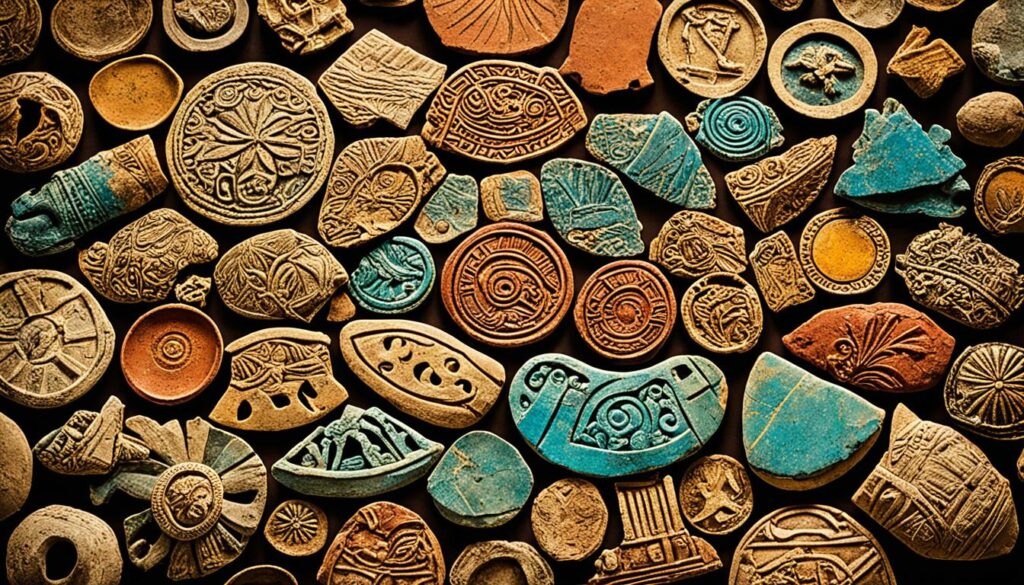
“Every artifact unearthed in Samaria tells a story—a story of a vibrant civilization, complex societies, and human ingenuity. It is through these discoveries that we can understand and appreciate the rich historical tapestry of Samaria.” – Dr. Sarah Johnson, Archaeologist
Excavation Sites in Samaria
Aside from Tel Samaria, several other excavation sites have contributed to our understanding of ancient Samaria. These include:
- Tel Shechem – A site containing structures and artifacts dating back to the Bronze and Iron Ages.
- Tel Shiloh – The biblical city where the Ark of the Covenant resided before being moved to Jerusalem.
- Beit El – A site with remnants of ancient buildings and religious structures.
- Tel Dothan – A location associated with the biblical story of Joseph and his brothers.
The ongoing archaeological work in these sites continues to unveil new discoveries, enriching our knowledge of Samaria’s past and providing valuable insights into the ancient world.
| Excavation Site | Significance |
|---|---|
| Tel Shechem | Reveals insights into the urban development and cultural practices of the region during different historical periods. |
| Tel Shiloh | Sheds light on religious and spiritual practices, including the worship of ancient Israelites. |
| Beit El | Provides evidence of ancient settlement patterns and the architectural styles prevalent in Samaria. |
| Tel Dothan | Offers insights into the geopolitical landscape and trade routes of the ancient region. |
Theological Themes in Samaria
Samaria, as portrayed in the Bible, encompasses a myriad of captivating theological themes that resonate with readers across cultures and generations. These themes emphasize the spiritual teachings and religious beliefs witnessed in the encounters between Jesus and Samaritans. The profound stories challenge societal norms, exemplify compassion, and celebrate the universality of salvation.
One prominent theological theme depicted in Samaria is compassion. Jesus’ encounter with the Samaritan woman at the well illustrates the transformative power of compassion, breaking down cultural and religious barriers. The story encourages readers to embrace a spirit of empathy and understanding, highlighting the essential role compassion plays in fostering harmonious relationships.
“But a Samaritan, as he traveled, came where the man was; and when he saw him, he took pity on him.”
– Luke 10:33 (NIV)
Inclusivity is another fundamental theme embedded in the stories set in Samaria. The Parable of the Good Samaritan challenges prejudice and highlights the importance of accepting individuals from different cultural and ethnic backgrounds. By choosing a Samaritan as the hero of the story, Jesus teaches the valuable lesson that true neighborly love embraces all, regardless of social or religious distinctions. This inclusive message continues to inspire and guide individuals today.
Furthermore, the theological themes in Samaria emphasize the breaking down of religious and cultural barriers. Samaritans held distinct religious beliefs and practices that diverged from mainstream Jewish traditions. Yet, Jesus’ interactions with Samaritans demonstrate the universality of God’s love and the invitation to embrace diverse expressions of faith. These stories encourage readers to cultivate an environment of respect and understanding among different religious communities.
The theological themes in Samaria serve as a profound reminder of the core values of love, mercy, and inclusivity. They provide spiritual teachings that transcend cultural, ethnic, and religious divisions, reinforcing the timeless messages of compassion found in the Bible.
Key Theological Themes:
- Compassion
- Inclusivity
- Breaking down religious and cultural barriers
| Theological Themes | Description |
|---|---|
| Compassion | Highlights the transformative power of compassion in breaking down cultural and religious barriers. |
| Inclusivity | Emphasizes the acceptance of individuals from different cultural and ethnic backgrounds. |
| Breaking down religious and cultural barriers | Encourages the embrace of diverse expressions of faith and the dismantling of divisions. |
Key Biblical Events in Samaria
Samaria, a significant region in the Bible, serves as the backdrop for several key biblical events, shedding light on the profound spiritual truths and timeless lessons that continue to resonate with readers today.
The Parable of the Good Samaritan
The Parable of the Good Samaritan is a well-known story that highlights the compassion and kindness of a Samaritan towards a wounded Jew. This parable, shared by Jesus, challenges societal norms and teaches the importance of showing mercy and love to all, regardless of cultural or ethnic backgrounds.
The Encounter at the Well
Another significant event in Samaria is the encounter between Jesus and the Samaritan woman at the well. This encounter reveals profound spiritual truths and emphasizes the universality of salvation. Jesus, breaking down cultural barriers, offers the woman living water, symbolizing the gift of eternal life and spiritual fulfillment.
“But whoever drinks of the water that I shall give him will never thirst. Indeed, the water I give him will become in him a spring of water welling up to eternal life.” – John 4:14
These key biblical events in Samaria provide powerful examples of love, compassion, and faith. They inspire readers to embrace these virtues in their own lives and serve as a reminder of the transformative power of genuine care for others.
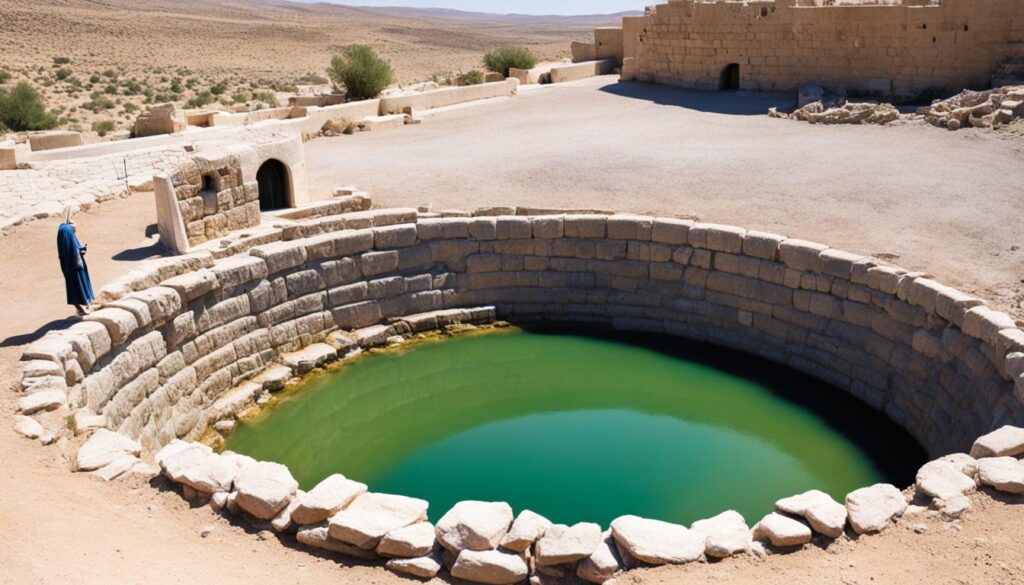
| Event | Description |
|---|---|
| The Parable of the Good Samaritan | Highlights the compassion and kindness of a Samaritan towards a wounded Jew, emphasizing the importance of showing mercy and love to all. |
| The Encounter at the Well | Reveals profound spiritual truths and emphasizes the universality of salvation, breaking down cultural barriers. |
Cultural and Religious Practices in Samaria
The Samaritans had their own unique cultural practices and religious rituals that reflected their distinct identity. The Samaritans were a mixed ethnic group that combined Israelite traditions with influences from other cultures within the region. This cultural diversity shaped their religious observances and provided valuable insights into the daily life of the Samaritan people.
One of the essential elements of Samaritan culture was their adherence to Samaritan traditions that were passed down from generation to generation. These traditions encompassed various aspects of their lives, including religious practices, social customs, and family traditions. They were a way for the Samaritans to maintain a strong sense of identity and preserve their unique heritage.
The Samaritans also had distinct Samaritan customs that governed their interactions and behaviors. These customs formed the foundation of their social norms and helped maintain harmonious relationships within the community. They reflected the values of kindness, hospitality, and respect for elders, emphasizing the importance of community and strong familial ties.
Influences on Religious Observances
The cultural practices of the Samaritans had a significant impact on their religious rituals. The blending of Israelite traditions with elements from other cultures contributed to the development of unique religious observances. These practices allowed the Samaritans to express their spirituality while incorporating local customs and beliefs.
“Our religious rituals are a testament to the cultural diversity within Samaria. We embrace our Israelite heritage while acknowledging the influences of the world around us. It is this blend that makes our worship meaningful and inclusive.”
Religious rituals in Samaria encompassed various aspects of life, such as ceremonies, festivals, and daily worship. These rituals provided opportunities for the Samaritans to connect with the divine and seek spiritual guidance. They were characterized by their reverence for sacred sites and artifacts, adherence to prescribed rituals, and communal participation.
The Role of Cultural Diversity
The cultural practices and religious rituals in Samaria arose from the region’s rich cultural diversity. The Samaritans’ mixed ethnicity allowed for the exchange of ideas and the incorporation of different customs into their way of life. This cultural diversity fostered a more inclusive and open-minded approach to religious practices.
The cultural practices and religious rituals in Samaria represent an important chapter in the history of the region and offer valuable insights into the diverse cultures and beliefs that coexisted within ancient Samaria.
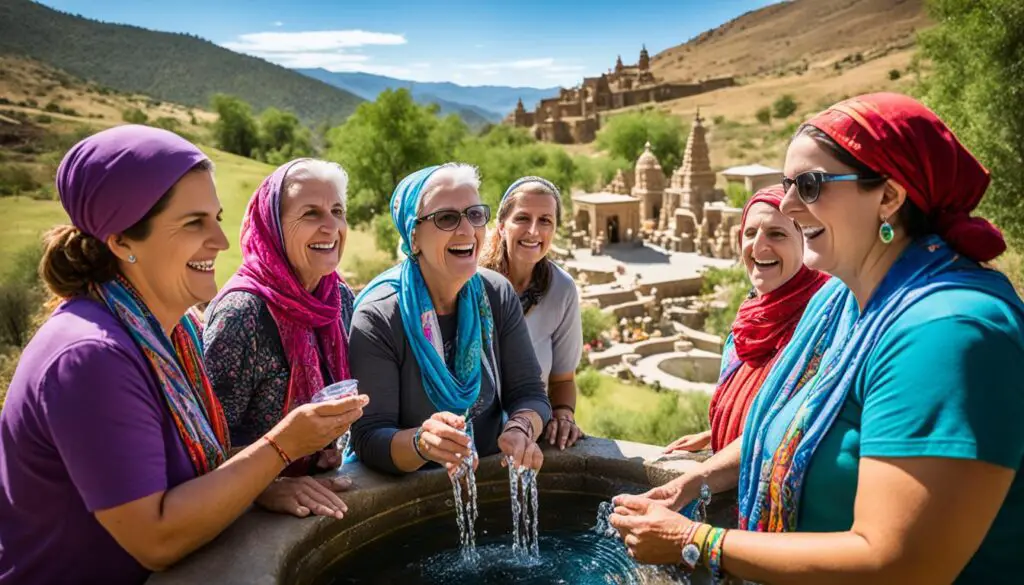
Prophetic and Eschatological Significance of Samaria
Within biblical texts, Samaria holds immense prophetic and eschatological importance. Throughout history, prophets delivered messages concerning Samaria, often foretelling impending judgment or future restoration. The destiny of Samaria became intricately intertwined with that of the Israelites, reflecting a deep connection and shared fate.
The prophecies related to Samaria provide profound insights into the Israelite understanding of their history and future. These prophetic themes add depth and dimension to the biblical narrative, offering a profound glimpse into the divine plan and purpose for the region.
“Behold, I am bringing disaster upon you from afar, declared the Lord. All you who drink up the cup of wrath shall drink it to the dregs.”
– Jeremiah 25:27 (ESV)
Prophetic utterances served as both warnings and promises, shaping the understanding of Samaria’s prophetic significance. They highlighted the consequences of disobedience or the hope of restoration, allowing the Israelites to grapple with their past, present, and future.
By exploring these prophecies, we delve deeper into the mysteries of Samaria, uncovering profound insights into its eschatological role and prophetic significance.

The Prophecies of Samaria
| Prophetic Figure | Prophecy |
|---|---|
| Amos | “Thus says the Lord: For three transgressions of Damascus, and for four, I will not revoke the punishment, because they have threshed Gilead with threshing sledges of iron.” – Amos 1:3 (ESV) |
| Hosea | “And I will have mercy on No Mercy, and I will say to Not My People, ‘You are my people’; and he shall say, ‘You are my God.’ – Hosea 2:23 (ESV) |
| Micah | “Therefore, because of you, Zion shall be plowed as a field; Jerusalem shall become a heap of ruins, and the mountain of the house a wooded height.” – Micah 3:12 (ESV) |
The prophecies related to Samaria demonstrate the intricate link between divine judgment, redemption, and the destiny of the region. They invite contemplation and reflection, encouraging readers to ponder the larger eschatological implications in the context of their own faith journeys.
“And to the angel of the church in Ephesus write: ‘The words of him who holds the seven stars in his right hand, who walks among the seven golden lampstands.”
– Revelation 2:1 (ESV)
As we explore the prophecies tied to Samaria, we gain a deeper appreciation for the rich tapestry of biblical history and the prophetic messages that continue to resonate throughout time.
The Enduring Legacy of Samaria
The stories and teachings from Samaria continue to have an enduring legacy. They offer lessons on the importance of compassion, inclusivity, and breaking down cultural and religious barriers. The Samaritans serve as examples of the transformative power of love and mercy, inspiring readers to embrace these values in their own lives. The enduring legacy of Samaria invites a broader and more inclusive understanding of faith and humanity.
Lessons from Samarian Stories
The stories originating from Samaria provide valuable lessons that are still relevant in today’s modern world. One such lesson is the significance of compassion. The story of the Good Samaritan, for instance, teaches us to show kindness and help those in need, regardless of their background or beliefs.
In addition, the stories from Samaria also highlight the importance of inclusivity. Despite the cultural and religious divisions of their time, the Samaritans demonstrated the value of accepting and embracing others, regardless of social or ethnic differences.
Relevance of Samaria in Modern Times
The relevance of Samaria extends beyond its historical context. The enduring legacy of Samaria serves as a reminder that compassion, inclusivity, and understanding are timeless values that can positively impact our lives.
In today’s world, where cultural and religious differences can sometimes create barriers, the lessons from Samaria offer guidance on how to bridge those divides and foster a greater sense of unity and empathy among individuals and communities.
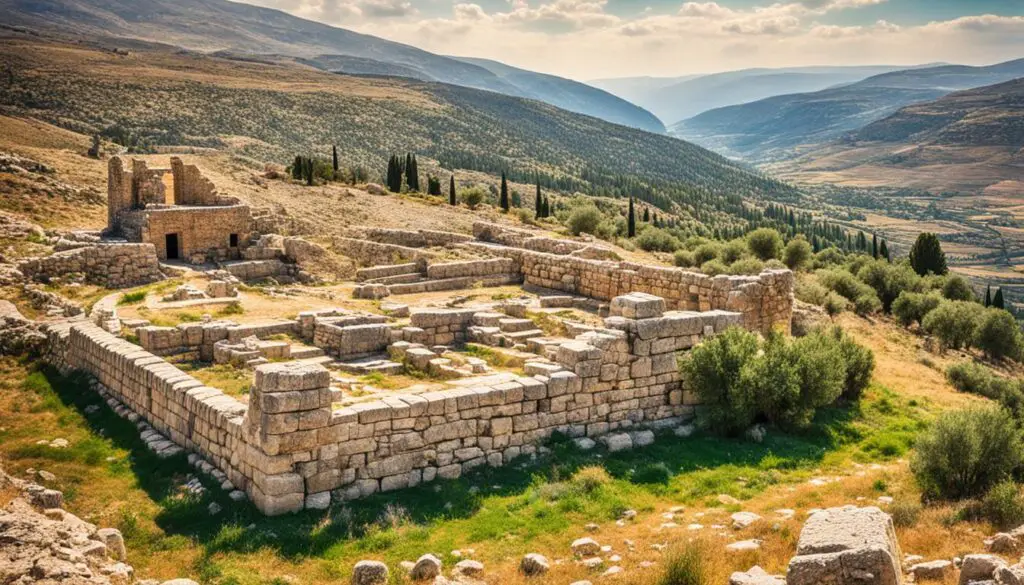
By drawing inspiration from the stories and teachings of Samaria, we can gain valuable insights into how to cultivate a more compassionate, inclusive, and harmonious society, one that embraces diversity and recognizes the shared humanity of all people.
Conclusion
In conclusion, Samaria in the Bible holds immense significance and provides a multifaceted understanding of history, culture, theology, and the human experience. Through stories, events, and teachings, Samaria emphasizes the timeless values of compassion, inclusivity, and the transformative power of love. Delving deeper into the biblical narrative surrounding Samaria allows readers to cultivate a broader perspective on faith, cultural divisions, and the enduring lessons that continue to resonate today.
Samaria’s historical and geographical context within the ancient Northern Kingdom of Israel, along with its unique cultural and religious practices, adds depth to the biblical accounts and highlights the diversity within the region. The encounters between Jesus and Samaritans, such as the Parable of the Good Samaritan and the conversation with the Samaritan woman at the well, demonstrate the breaking down of barriers and the universality of salvation.
Additionally, the prophetic and eschatological significance attached to Samaria in the Bible reinforces its role in the spiritual journey of the Israelites. The enduring legacy of Samaria lies in its teachings on compassion, inclusivity, and the power of love to transform individuals and communities. By studying Samaria, readers are encouraged to embrace these values and integrate them into their own lives, fostering a more inclusive understanding of faith and humanity.
FAQ
What is the significance of Samaria in the Bible?
Samaria holds a significant place in the Bible, featuring prominently in both the Old and New Testaments. It originated from the ancient Northern Kingdom of Israel after the Assyrian conquest in 722 BCE. The encounters between Jesus and Samaritans, such as the Parable of the Good Samaritan and the encounter with the Samaritan woman at the well, highlight the themes of compassion, inclusivity, and the universality of salvation. The tensions between Jews and Samaritans are evident throughout the Bible, but the stories of the Samaritans serve as a timeless lesson on breaking down cultural and religious barriers.
Where was Samaria located in ancient times?
Samaria was located in the ancient Northern Kingdom of Israel, covering the central part of present-day Israel and parts of the West Bank. It was centered around the city of Samaria, which served as the capital of the Northern Kingdom. The region of Samaria still exists today, encompassing the modern cities of Nablus and surrounding areas in the West Bank.
What archaeological discoveries have been made in Samaria?
Archaeological excavations in Samaria have unearthed numerous artifacts and provided valuable insights into the ancient culture and history of the region. Excavation sites such as Tel Samaria have revealed remains of ancient buildings, pottery, and other archaeological treasures. These discoveries help paint a picture of life in ancient Samaria and provide evidence of the region’s historical significance.
What theological themes are associated with Samaria?
The encounters between Jesus and Samaritans highlight concepts such as compassion, inclusivity, and the universality of salvation. These stories challenge societal norms and offer spiritual teachings that transcend cultural and ethnic divisions. The theological themes in Samaria emphasize love, mercy, and the breaking down of religious and cultural barriers.
What are some key biblical events that took place in Samaria?
Stories such as the Parable of the Good Samaritan highlight the compassion and kindness of a Samaritan towards a wounded Jew. The encounter between Jesus and the Samaritan woman at the well reveals profound spiritual truths and emphasizes the universality of salvation. These stories and events serve as powerful examples of love and faith that continue to resonate with readers today.
What were the cultural and religious practices in ancient Samaria?
The Samaritans had their own unique cultural and religious practices. These practices combined Israelite traditions with elements from other cultures due to the mixed ethnicity of the Samaritan people. Their customs and rituals provide insights into the cultural diversity within the region and how it influenced their religious observances.
What is the prophetic significance of Samaria?
Samaria holds prophetic and eschatological significance in biblical texts. Prophets often spoke about Samaria, delivering messages about impending judgment or future restoration. The fate of Samaria was seen as interconnected with the destiny of the Israelites. Understanding the prophetic themes tied to Samaria adds depth to the biblical narrative and provides insights into the Israelite understanding of their history and future.
What is the enduring legacy of Samaria?
The stories and teachings from Samaria continue to have an enduring legacy. They offer lessons on the importance of compassion, inclusivity, and breaking down cultural and religious barriers. The Samaritans serve as examples of the transformative power of love and mercy, inspiring readers to embrace these values in their own lives. The enduring legacy of Samaria invites a broader and more inclusive understanding of faith and humanity.


